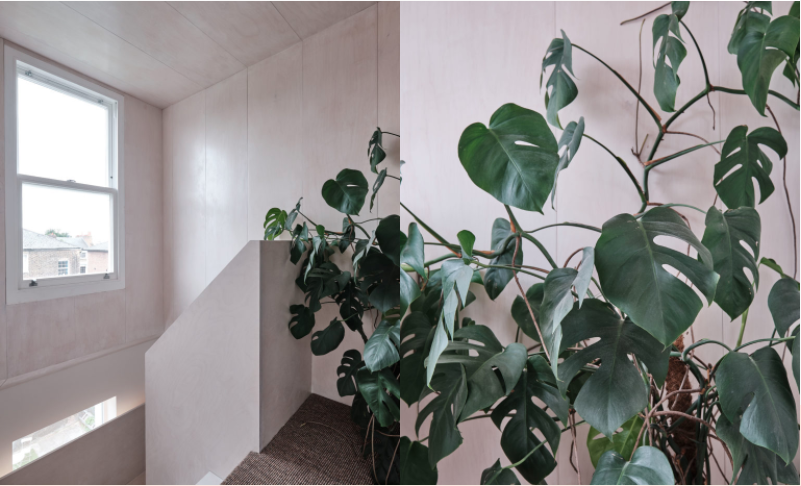How to grow a garden, wherever you live
The homes we sell here at Aucoot are far from conventional, and that goes for their corresponding outdoor spaces, too. As we have found ourselves confined to closer quarters, the premium on green space is unsurprisingly higher than ever. So, for the city-dwellers among us, how do you make every last square inch of green count? Award-winning garden and landscape designer, Ula Maria, has carved out a career from her ability to spot the potential in a whole multitude of unconventional spaces. Last year, she published her book Green – an ode to the charms and idiosyncrasies of atypical plots, and a guide on how to enable them to reach their full potential. Here, she tells us how it’s possible to grow a garden, wherever you live.
Though there may be a shortage of rolling acres in the city, roof terraces can offer much needed respite from the concrete sprawl, as well as unique views of the city skyline. “Rooftop gardens are amazing, and they can feel quite surreal because you usually have incredible views. Also, the light levels are often really good,” says Maria. “I think just being able to use every bit of space – right down to the roof – is a wonderful thing.” She recommends maintaining privacy from close-by neighbours with tall ornamental grasses – particularly calamagrostis and miscanthis – and trees to filter sunlight. “Recently I’ve been working on one rooftop garden in particular and we’ve introduced a number of planters that are slightly set inwards from the perimeter of the terrace. At points where more shelter or screening from neighbours is needed, we’ve introduced slightly higher planters and planted shrub trees in these,” Maria says, though she advises checking the roof’s loading capacity beforehand. For very exposed plots, a canopy sail or wooden pergola is ideal for sheltering from the midday sun in summer, while living green roofs will not only soften and conceal any ugly hard landscaping, they’ll also provide a safe haven for wildlife.
A smart courtyard is a botanical boon for those living in the city, no matter how modestly sized. “Most of the gardens I work on are courtyards – especially within London. I think they’re quite exciting spaces to work with because, being naturally enclosed by walls and boundaries of other gardens, they become these secluded spaces within which you can create any sort of atmosphere that you want,” Maria explains. “Obviously, it’s dictated by light levels and garden orientation, but generally courtyards give you free rein to explore whatever style you want, whereas for large open spaces in the countryside you really need to take the broader context into consideration.” Living walls are a resourceful solution to scant square footage and lend a touch of drama to smaller plots, drawing the eye skywards. While large doors that open out fully create a seamless border between the inside and outdoors, which immediately makes a home feel bigger. For basement flats, a slightly sunken courtyard with less light can prove trickier, so Maria recommends choosing shade tolerant ferns to create an intimate green fortress: “There’s been a huge interest in tree ferns and these are amazing plants to grow in shady gardens, and work so well in enclosed London courtyards.”
Even if your plot is lacking in any landscape of sorts, Maria argues it’s still possible to create an enviable set up. “With a small balcony, one of the key things is to create layers of texture to obscure the boundaries and really explore every surface that you have – so try to fix pots on the boundary lines and introduce vertical planting with climber plants,” she suggests. Those lucky enough to live in factory conversions will have the added benefit of extra large, light-funnelling windows, allowing indoor plants to thrive like nowhere else. Pool your plants along the sill in varying heights and textures. “The only rule I’d suggest following is instead of going for lots of colour, introduce lots of different shades of green. By just using a variety of green plants you can create something spectacular that looks really contemporary,” says Maria.
For those in attic apartments, the stairwell, windowsills or ledges and skylights are all prime locations to for plants to flourish. Plus, shade-loving low-maintenance varieties like the ZZ plant, the maidenhead fern, or the peace lily can be dotted around darker spots. “For attic spaces, I’d suggest grouping lots of plants in varying heights together. The rule I always go with is the plant should always be bigger than its pot, so that the foliage is the focus. So, as much green as possible at different levels and heights”‘ says Maria. “Another important thing for working with small spaces is to introduce larger plants. Sometimes putting something quite big in a small space makes it appear more grand and more generous than it actually is.”









